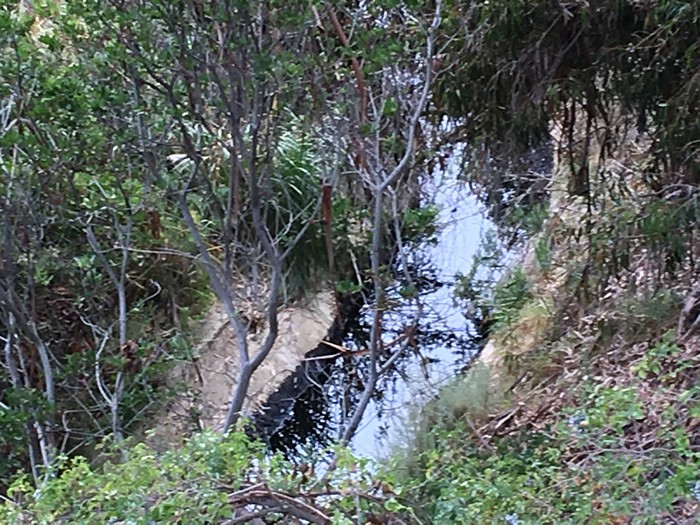Spilled crude oil stopped before reaching the ocean.
On June 23, at 5:30am, a crude oil spill was reported in the northwestern part of Ventura. The spill traveled a half mile from the Prince Barranca into Hall Canyon. Early reports (including the LA Times) greatly exaggerated the amount of the oil spilled. It was eventually confirmed to be about 700 barrels (29,400 gallons) of crude oil. The pump station where the leak occurred was quickly shut down to keep the spill to a minimum. The flow traveled about a half mile and ended up in a catch basin in the Prince Barranca and did not flow out to the ocean.
The pipeline was carrying oil produced by Area Energy and is owned and operated by Crimson Pipeline.
Community members were sent the following VC Alert message, “The oil spill in Hall Canyon is currently contained in the Prince Barranca. Crews will be working around the area and residents are advised to avoid contact with the oil and take safeguards to protect pets and property. Residents may smell strong odors and at this time air quality monitoring is taking place. Further information will be released as it becomes available.” Residents may request VC Alert notifications by texting “VC Alert to “313131”.
Many Venturans and city officials are not happy with the response and information provided by Crimson.
Ventura resident Robert Louis Chianese stated, “Our City Manager Mark Watkins has subpoenaed the Crimson Pipeline company. It’s amazing because the State of California regulates pipe lines without local officials’ involvement. I think this time, the oil company reps and others at our public meeting last night were fooling with us the whole time, and we were very angry to find out in the morning that they had re-pressured the pipe and sent it flowing with oil. There are still pools of oil in the Barranca, and the clean-up could last weeks. Crimson has had 11 spills since 2006, and while this one allegedly involves a valve, the pipe itself is 75 years old.
“Manager Watkins did something about it. It is actually very moving in his concern for the citizens and those of us close to the spill. Watkins’ anger underlies much of it too. This ought to make the national news just for the uniqueness of it with a public servant pushing for a member of “big oil” to cease and desist with the pumping and come clean with all the information we need to know to determine what we should do with that pipeline.”
In his letter dated July 1, 2016 to Crimson Pipeline, Ventura City Manager Mark Watkins stated in part.
“On June 30, 2016 the Unified Command including Crimson Pipeline held a neighborhood meeting – hosted by the City – to provide a forum for residents to receive information and ask questions about the incident. A representative from the California Department of Fish and Wildlife and Crimson responded that before the line would be allowed to resume operations it would be approved by the State Fire Marshal’s Office and there was a process and protocol to be followed before that could happen.”
“Crimson Pipeline personnel that attended the meeting agreed on the process and status of the pipeline. It has since come to our attention that Crimson Pipeline was putting the pipeline into testing phase during the meeting and has since resumed use of the pipeline. It is evident that the information given to me and our residents during the neighborhood meeting was not transparent or forthcoming. The City and its residents deserve a reasonable notice prior to resuming use of the pipeline. “
“The City stands by its neighbors and requests that Crimson Pipeline LLC provide a full, accurate, and honest accounting of the facts to our residents. To this end, the City requests that Crimson Pipeline:”
Shut down the pipeline immediately.
Provide the City and its impacted residents with information about the safety, process and timeline of the pipeline in advance of its resuming operation.
Comply with the City’s legislative subpoena Provide the cause of the oil spill.
Report back the actions taken to repair the pipeline and/or valve.
Provide a summary of testing for the valve and/or pipeline.
Provide protocols and/or process for resuming use of the pipeline.”

